|
Water News - Caithness - Highland - Scotland
6 June 07
Have your say in shaping Scotland's water plan
Residents in the North Highland area are invited to help shape future
plans to protect and improve water quality at informal, open meetings on
18 June and 20 June 2007.
Following the introduction of European
legislation, the Scottish Environment Protection Agency (SEPA) is
preparing a plan that will reflect the aspirations of all of those using,
managing and protecting Scotland's water environment. This plan, which
will be produced in 2009, will include measures to benefit rivers, lochs
and coastal waters in the North Highland area covering catchments draining
to the coast between Cape Wrath and Lossiemouth.
Tom Inglis of SEPA, said, "Effectively
involving others is central to the
delivery of the plan and we are eager to ensure that as many people as
possible are involved at an early stage. To help with this, we've arranged
a meeting to provide more information on what's happening when and those
interested in ensuring a healthy water environment should come along to
the meeting to find out how they can get involved."
The meetings will be held at 3-5pm and 7-9pm
on 18 June in the Pentland Hotel, Thurso and 3-5pm and 7-9 pm in the
Inverness Caledonian Thistle Football Stadium (Kingsmills Suite) on 20
June. Each meeting will consist of a series of short presentations and an
informal discussion. Refreshments will be available and those interested
in attending should email
Rachel.harding-hill@sepa.org.uk or call on 01349 860347.
Notes
-
The Water Framework Directive (2000/60/EC)
came into force on 22/12/2000 and establishes a new legal framework for
the protection, improvement and sustainable use of all water in the
natural environment across Europe.
-
The Directive has been transposed into
Scottish law via the
Water Environment and Water Services (Scotland) Act
2003. A requirement of the Act is the development of a river basin
planning system based upon River Basin Districts which are made up of
groups of individual river basins and catchments; this is required under
'The Water Environment (Water Framework Directive) (Scotland River Basin
District) Regulations 2004'.
-
The Scotland River Basin District has been
divided into eight areas, with one area covering the North Highland area.
Each area will have a specific 'chapter' within the plan, which will be
prepared with the advice and assistance of key stakeholders in the area.
-
The River Basin Management Plan is a 6-yearly
statement which sets out how SEPA is meeting the requirements of the Water
Framework Directive and how we are planning to continue to do so.
Producing such plans will involve identifying risks to the status of
Scotland's water environment, and assessing how and to what extent these
risks can be addressed during the period covered by the plan and by
subsequent plans.
13 November 06
£60,000 OVERHAUL FOR CAITHNESS WATER MAINS
Three Caithness communities, whose elderly water mains have
deteriorated, causing bursts and supply interruptions, have been targeted
for investment by Scottish Water.
Work is getting underway this week (w/b 13
Nov) in Halkirk. 180 metres of pipe in the Sinclair Lane area is to be
replaced. Work is also due to get underway in the coming weeks in the Elzy
Road area of Staxigoe and the Green Road area of Wick where several
hundred metres of pipe is earmarked for replacement.
Andy Barnett, project manager for Scottish
Water Solutions, said: "Together these projects are worth about £60,000 -
a substantial investment which will benefit customers in these areas. The
existing mains are thought to be up to 60 years old and are made from a
mixture of cast iron, cement and plastic. The new pipes are made from more
durable material and will serve these communities well for many years to
come."
Minimum disruption
The water mains replacement work in the three communities is being
carried out using a 'pipe-bursting' technique, which means that there is
little need to dig up roads or pavements. A device attached to the head of
the new pipe smashes through the old water main and the new pipe is
dragged through the resulting tunnel. Advance warning will be given to
customers if supplies need to be interrupted to connect to the new pipes.
Highland Council's roads department will advise if any traffic management
is needed.
Investing in Highland
Since it was created in 2002, Scottish Water has replaced a
record-breaking length of water mains across Scotland: over 2,500km, the
distance from Inverness to Bucharest. However, that's only 6% of the
entire water mains network in Scotland. Scottish Water is faced with a
huge job following decades of neglect.
Since 2002, Scottish Water has invested over £2,000 per household in
the Highlands, compared to a Scottish average of £820. A £2.4billion
investment programme for Scotland for the next four years will continue
the transformation of the country's infrastructure.
22 August 06
Managing And Protecting Scotland's
Water
From now, all of Scotland's rivers, lochs and wetland habitats will be
managed to allow sustainable use, while protecting and enhancing the water
environment. This is of paramount importance to the Scottish Environment
Protection Agency (SEPA).
Today (22 August 2006) SEPA is issuing annual
subsistence charges for abstraction for the first time and, SEPA is taking
this opportunity to provide
an explanatory note with these invoices. The inclusion of the explanatory
note is in response to feedback from various sectors regarding how and why
charges are issued.
The charges will allow SEPA, over the next
ten years, to deliver major improvements in the water environment,
providing amenity, recreational and economic benefits which are dependent
on a good water environment. The cost of delivering these important
improvements will be recovered by the new charging scheme which reflects
the cost recovery principle that funds SEPA's work. The charges were
calculated on the basis of the Water Environment Charging scheme which was
approved by the Scottish Ministers in March 2006.
The charge is relative to the amount of risk
that different types of activity pose to the environment and, as a result,
the amount of work SEPA will put in to regulating activities and
monitoring the environment. To understand the charge it is important to
understand the scale of abstraction, for example, a mobile irrigation unit
uses the same water as 6, 000 people in one day.
Following the introduction of the new
regulations, there have been a number of questions; for example:
-
What is the money used for? Firstly,
environmental monitoring; the money is used to monitor the flows in rivers
and levels in lochs; to assess the ecological conditions and impacts in
the water environment.
-
Secondly, regulation; here the money is used
to assess whether licences are being complied with; to promote good water
use and to take enforcement action where operators abstract illegally.
-
What if I have registered for a licence but
do not intend to abstract? If you have registered for a licence, but are
sure that you will not need to use it, then you can write to SEPA between
the 1st December and the 27th February. SEPA will write back with
confirmation and you will not then be charged any subsistence in the April
and October billing run.
-
What if I haven't got a licence? If you have
not applied for a licence for your abstraction, dam or weir you should
apply before the end of September after which application charges
increase.
Martin Marsden, Water Policy Unit Manager for
SEPA said, " The environment is important to us all, not only for our
quality of life but also for the economic development of Scotland. We have
worked with water users over the past two years, to develop a charging
scheme which focuses on activities which pose a risk to the environment. I
firmly believe that the outcome is a fair charge for the work."
SEPA has a duty to secure the proper use of
water resources in Scotland, not only is this integral to the
environmental well being of Scotland, but it is also the lifeblood of
Scotland's agricultural industry and tourism.
A Questions & Answers document is available at:
http://www.sepa.org.uk/wfd/index.htm
18 July 06
Water quality results ahead of target
The Scottish Environment Protection Agency (SEPA) announced Scotland's
waters are well on track to meet all 2006 targets, with the recent
improvements in coastal water quality being particularly notable. These
promising results follow the 2005 monitoring of water quality in
Scotland's rivers, estuaries and coastal waters and are, in summary:
· Rivers: target 351km, actual achieved =
393km
· Estuaries: target 6.5km2, actual achieved = 10.6km2
· Coastal waters: target 145km, actual achieved = 209km
The target set for reducing the length of
poor water quality in Scotland's
rivers and streams (class C and D) between 1999 and 2006 was 351km (a
target SEPA set itself for water quality improvement for 2006). Results
show that at the end of 2005, a reduction of 393km has been achieved and
more improvements are anticipated. The outcome of targets will be reported
after all 2006 data has been assessed.
For estuaries, the target set was to reduce
the unsatisfactory areas by 6.5km2, and to date 10.6km2 has been achieved.
Coastal waters improvements in 2005 have also given a total reduction of
209km, which substantially exceeds the target to improve 145km by next
year.
A key driver of these enhancements has been
the implementation of SEPA's Environmental Improvement Action Plans. As
well as the improvements to sewerage infrastructure and effluent treatment
schemes and other best practice initiatives, combined with the Scottish
Executive's four-point plan to minimise pollution from livestock, have all
helped reduce impacts.
SEPA's Head of Environmental Quality, Dr. Tom
Leatherland, said: "It's very rewarding to see these significant
improvements in water quality across Scotland. They're the result of
carefully targeted investments, and the continuing efforts to reduce
diffuse pollution from agricultural activities, now showing positive
results. We've also made good progress in extending our river
classification network and this has helped identify areas where further
improvement is required."
"There's a need for further improvements as
indicated by the long list of future investment requirements. There are
many sources of both urban and rural diffuse pollution which still need to
be minimised, as well as the river flow and physical standards arising
from the Water Framework Directive (WFD) which should be met. The new,
more demanding, European Union (EU) WFD classification measures will soon
be applied. Last year, SEPA published a preliminary assessment of waters,
which may not meet the exacting standards of the new WFD classification
measures, without the intervention of management measures."
"The next few years will be very exciting as
current schemes deliver improvements, and we develop 'River Basin
Management Plans' to meet the requirements of the WFD over a longer
timescale."
Notes
· The reported rivers and coastal results are available at:
http://www.sepa.org.uk/pdf/data/classification/water_qual_class_2005.pdf
· Quality Classes for rivers are:
Excellent A1
Good A2
Fair B
Poor C
Seriously polluted D
The length of generally more remote
"Unclassified, assumed Class A" rivers has been reduced from almost
13,000km in 2000 to 2,100 km in 2005, through improvements made to the
monitoring network. A quality status for the whole length has to be
assigned in 2008 for EU WFD purposes.
For estuaries and coastal waters the quality
classes are:
Excellent A
Good B
Unsatisfactory (fair/ poor) C
Seriously polluted D
· Full biological treatment of substantial
discharges of sewage effluents to
tidal waters is now the norm, as it has been in freshwaters for many
years.
Also, where necessary, an increasing number
of effluents are now subject to additional 'tertiary' treatment of various
types, dependent upon the sensitivity of the receiving water.
· Other best practice initiatives include;
Sustainable Urban Drainage Schemes (SUDS); the 'Forest and Water
Guidelines' and new guidance on the 'Prevention of Environmental Pollution
from Agricultural Activities' (PEPFAA Code).
· The EU Water Framework Directive standards
cover water quantity and physical factors as well as the chemical and
biological aspects currently monitored. The default target is overall good
status, rather than just the elimination of pollution. Implications of the
emerging standards have been described in the current characterisation
reports which are available on SEPA's website
www.sepa.org.uk
29 November 05
SCOTTISH WATER TAKING ‘STEPS’ TO IMPROVE
WASTE WATER DISCHARGE AT WHALIGOE
£150,000 of work is underway which will stop sewage trickling down the
cliffs next to the famous Whaligoe Steps in Caithness.
Currently, waste water from households in the
area collects in a septic tank near the top of the steps. It discharges
liquid into a nearby burn which then trickles down the cliff-face.
Audit Scotland
Report On Scottish Water Oct 2005
Main report (PDF | 1.8MB, 48 pages)
Key findings (PDF | 616KB, 6 pages
Main report (RTF | 184KB)
Key findings (RTF | 28KB)
Outfall pipe hidden within the cliffs
The work getting underway involves a new outfall pipe constructed
within the cliffs, taking the discharge out to sea. This will benefit the
environment and hopefully boost the location’s reputation as a visitor
attraction.
The pipe is being drilled through tough
Caithness flagstone using a technique called Directional Drilling. This is
a technique often used in the oil industry to find sub-sea pockets of fuel
but is rarely used in the water industry.
The work is expected to be completed by the
end of this year.
The Whaligoe Steps
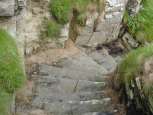 The
365 steps – one for each day of the year – were hewn from the sheer
cliff-face down to a natural harbour where herring boats used to unload
their cargoes. In the 19th century Caithness was the herring capital of
Europe. The local women would process the fish on a platform known as the
Bink. They would then carry it up the steps in baskets balanced on their
heads for salting or selling fresh to locals. The
365 steps – one for each day of the year – were hewn from the sheer
cliff-face down to a natural harbour where herring boats used to unload
their cargoes. In the 19th century Caithness was the herring capital of
Europe. The local women would process the fish on a platform known as the
Bink. They would then carry it up the steps in baskets balanced on their
heads for salting or selling fresh to locals.
Benefiting the birds
The cliffs in this area are internationally important for fulmars,
shags, kittiwakes, guillemots, razorbills and black guillemots. The new
system means that the final waste water discharge will go straight out to
sea without affecting the cliffs at all. Scottish Natural Heritage and the
Scottish Environment Protection Agency were consulted prior to the work
commencing.
Project manager Ross Murray said: “The
improved outfall point will be good news for the environment. We’ve also
programmed this work to take place outwith the normal tourist season as
the Whaligoe Steps are a popular attraction. And our drilling work will be
carried out with minimal disruption to people living nearby.”
26 October 05
£100,000 PROJECT IMPROVES WASTE WATER TREATMENT FOR HOUSES ON OUTSKIRTS OF
WICK
Homes in the Newtonhill area of Wick are benefiting from a Scottish
Water project worth approximately £100,000 which has resulted in their
waste water being given an improved level of treatment.
No more discharges into a ditch
Until now 6 households discharged into a septic tank which was 40 years
old and at capacity. Its final discharge was into a local ditch. This
situation has now ended, benefiting the local environment.
The septic tank has been converted into a
pumping station which now transfers the waste water via a new sewer pipe
to the main treatment plant at Wick, which treats waste water to a high,
modern standard.
During the work care was taken to keep noise
and traffic disruption to a minimum, especially as Newtonhill is near Wick
High School.
Investing in Caithness
Since its creation in 2002, Scottish Water has completed £134million of
improvements across the Highlands. The investment in new water treatment
works, waste water treatment works, water mains and sewers is being
delivered by Scottish Water Solutions, a partnership of utility companies
and contractors.
Here are some other Caithness projects
already complete:
-
Reay: 5 new septic tanks, worth a total of
£300,000, now installed. This ends the practise of pumping raw sewage into
the Pentland Firth.
-
Bower: Around £350,000 has been invested in a
new septic tank and reed bed to clean up the discharge into the Burn of
Bower.
-
Papigoe: £400,000 has been invested to stop
raw sewage going into the sea. Waste water is now pumped to the treatment
plant at Wick.
And here are some Caithness projects nearing
completion:
-
Thurso: £13million waste water
treatment works on schedule and due for completion by the end of the year.
-
Dunnet: £180,000 to clean up popular bathing
waters. New parts and equipment are being installed at the waste water
treatment works.
-
Castletown: £2.5million project will also
help improve the famous waters of Dunnet Bay.
-
Lybster: £500,000 project to end to raw
sewage trickling down cliffs. This is good news for residents and the
local wildlife.
Project manager Ross Murray said: “The
residents of Newtonhill can be assured that their waste water is now
receiving an improved and appropriate level of treatment. It’s all part of
our effort to clean up the environment.”
16 August 05
FURTHER BOOST FOR CAITHNESS ENVIRONMENT AS £2.5M PROJECT GETS UNDERWAY AT
CASTLETOWN
A £2.5million project to improve the famous waters of Dunnet Bay in
Caithness is getting underway.
A new waste water treatment system, involving a septic tank, is to be
installed about 1km west of Dunnet bathing beach to serve the community of
Castletown. This will replace the existing plant at Castlehill, providing
an improved level of treatment with a final discharge further away from
the bathing beach.
The work is being carried out by Morrison Construction and is due for
completion in the spring.
The tank will treat waste from the area’s
1,200 residents. It has been designed to cope with any future expansion of
the community. It can deal with waste from an extra 100 houses.
Dunnet Bay is about 5 miles east of Thurso.
The area is famed for wildlife such as otters, porpoises, whales,
dolphins, seals and puffins.
Keeping people informed
Scottish Water Solutions, the partnership of utility companies and
contractors delivering Scottish Water’s 2002-06 £18billion Capital
Investment Programme, has kept the community informed about the project
and will keep any disruption during the work to a minimum.
Investing in Caithness
The Castletown project is one of a number aimed at improving the Caithness
environment:
-
Thurso East: £13million waste water treatment
works on schedule and due for completion by the end of the year.
-
Dunnet: £180,000 to clean up popular bathing
waters. New parts and equipment are being installed at the waste water
treatment works.
-
Reay: 5 new septic tanks, worth a total of
£300,000, now installed. This ends the practise of pumping raw sewage into
the Pentland Firth.
-
Bower: Around £350,000 has been invested in a
new septic tank and reed bed to clean up the discharge into the Burn of
Bower.
-
Papigoe: £400,000 has been invested to stop
raw sewage going into the sea. Waste water is now pumped to the treatment
plant at Wick.
Stephen Munro, project manager at Scottish
Water Solutions, said: “It’s great that we’re getting started at
Castletown. This is a project with big environmental benefits and the
residents can be assured that their waste will receive an appropriate
level of treatment. This is a big investment for the whole community and I
look forward to it being delivered.”
John Crowden, chairman of Castletown and
District Community Council, said: “We have been pushing for an improvement
to the waste discharge for many years now and it is good that at last we
are getting a new plant purpose built to better treat the waste prior to
discharge. We have had some small improvements in the last few years that
have improved the water quality in the bay but this new discharge location
away from the beach and the level of treatment the waste will receive
prior to discharge will lead to a major improvement to the popular bathing
waters and beach of Dunnet Bay.”
31 March 05
More Waste Water Works - New Pumping Station At Papigoe To Replace
Septic Tanks
 The
two septic tanks in the village of Papigoe are being got rid of and
replaced with new pumping stations to take waste water round to the new
Waste Water works at North Head, Wick. the outfall from the septic
tanks has always drained into the sea but shortly this will stop. M
M Miller Ltd, Wick have the contract from Scottish Water to carry out the
work. The
two septic tanks in the village of Papigoe are being got rid of and
replaced with new pumping stations to take waste water round to the new
Waste Water works at North Head, Wick. the outfall from the septic
tanks has always drained into the sea but shortly this will stop. M
M Miller Ltd, Wick have the contract from Scottish Water to carry out the
work.
30 March 05
£13M THURSO WASTE WATER TREATMENT WORKS ON SCHEDULE
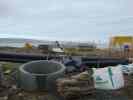
Managers of the project to construct a new waste water treatment works
for Thurso are reporting that work on the £13million scheme is on schedule
and due for completion by the end of the year. All the major
structures are well underway and drilling work for the sea outfall has
been completed.
The new works will improve
the quality of waste water going into the Pentland Firth ten-fold. This
improvement to the environment will boost Thurso’s reputation as a top
surfing destination.
Peter Wilson, project
manager for Scottish Water Solutions, said: “At the moment, sewage from
Thurso and Scrabster is subject to only very basic screening before being
discharged. The new works, being constructed at Thurso East near Harrold’s
Tower, will discharge through a new outfall in deep water out in Thurso
Bay. The treatment process we plan to use will bring great benefits to the
environment and I’m glad to report that work is on schedule.”
The Thurso project is the
largest single project within the 2002-06 Capital Investment Programme in
Scottish Water’s north-west area. The Capital Investment Programme is
worth £1.8billion, £152million of it in the Highlands and Islands.
The programme is being
delivered by Scottish Water Solutions, an award-winning partnership of
utility companies and contractors.
The work at Thurso East is
being carried out by Galliford Morgan Joint Venture, one of the partners
that make up Scottish Water Solutions.
Scottish Water is keen to
keep the community informed about progress at the site. Recently, children
from Mount Pleasant Primary School were given a talk by site staff about
being careful near a construction area and a poster competition was held
to help drive home the safety message.
14
February 05
New Waste Water Treatment Works At Lybster Under Construction
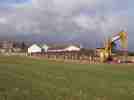 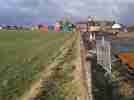
1 February 05
WASTE WATER PROJECTS TO
CLEAN UP CAITHNESS ENVIRONMENT
A package of improvements worth almost £1million is about to get
underway which will bring huge environmental benefits to the communities
of Papigoe, Broadhaven and Bower and people living in the Scalesburn and
Victoria Place areas of Wick. Approximately £212,000 is being
invested in a new septic tank and reed bed at Thura Place in Bower.
At Papigoe and Broadhaven a project worth around £402,000 will see
improved sewage treatment for the two villages. And in Wick new
screening is to be installed to help the storm overflows in Victoria Place
and Scalesburn cope better during adverse weather. The work is worth
approximately £295,000.
2 November 04
Gibson calls on underspend to be spent on
relieving development constraints
 Having visited the major Caithness water treatment plant Rob Gibson,
SNP MSP for Highlands and Islands described the new plant at Halkirk as a
shining example of what should be on offer to all Scottish Water
customers. Having visited the major Caithness water treatment plant Rob Gibson,
SNP MSP for Highlands and Islands described the new plant at Halkirk as a
shining example of what should be on offer to all Scottish Water
customers.
4 August 2004
Royal Opening of Loch Calder Water Treatment Works
 His Royal Highness The Prince
Charles, Duke of Rothesay, will officially open Loch Calder Water
Treatment works, at Hoy, near Halkirk in Caithness on Monday 2 August 2004. The
Royal Visit comes nearly 50 years after his grandmother, Her Majesty Queen
Elizabeth The Queen Mother, opened the original works in 1955. The brand new treatment works forms
part of Scottish Water’s North Coast Regional Scheme – the biggest single
investment in the water supply for the Highlands. The £28 million scheme
substantially improves the water quality supplied to around
30,000 customers in 13 communities in Caithness and along the north coast
of Sutherland. The scheme serves an area of over 70kms from John O’Groats
in the east to Tongue in the west.
His Royal Highness The Prince
Charles, Duke of Rothesay, will officially open Loch Calder Water
Treatment works, at Hoy, near Halkirk in Caithness on Monday 2 August 2004. The
Royal Visit comes nearly 50 years after his grandmother, Her Majesty Queen
Elizabeth The Queen Mother, opened the original works in 1955. The brand new treatment works forms
part of Scottish Water’s North Coast Regional Scheme – the biggest single
investment in the water supply for the Highlands. The £28 million scheme
substantially improves the water quality supplied to around
30,000 customers in 13 communities in Caithness and along the north coast
of Sutherland. The scheme serves an area of over 70kms from John O’Groats
in the east to Tongue in the west.
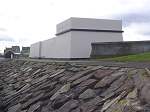
Sewage Pumping Station
Thurso
Construction of Wick Sewage Treatment Works 2002
Jan 2002
Scottish Water
Water Links
Earlier Water News |







